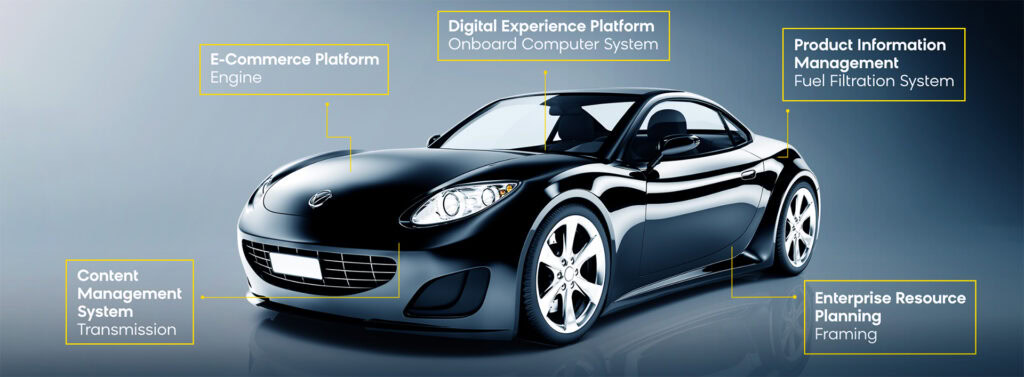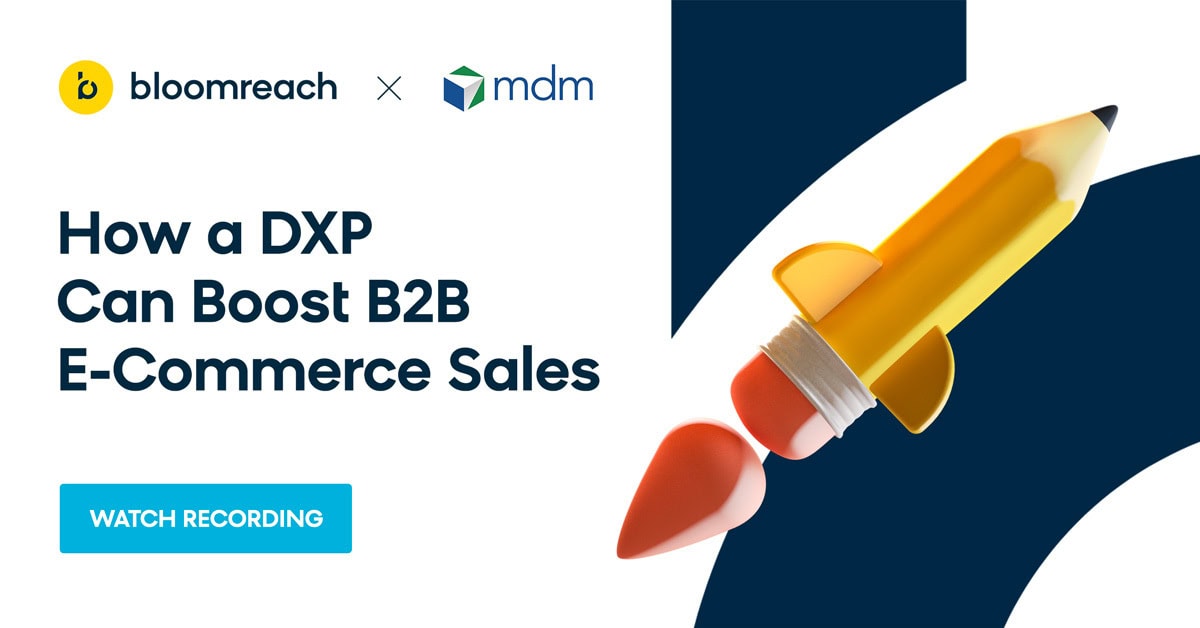Expanding purchasing and sales online can mean great things for a distributor of B2B products — new markets, more revenue, and less stress on your in-person sales force. However, for many B2B companies moving into digital for the first time, it can be overwhelming to make sense of all the new terminology, principles, metrics, and worst of all — the initialisms!
“CMSs, ERPs, and PIMs, oh my!” With all of these new concepts, it can be difficult to understand what is needed to power great online experiences that actually grow revenue. Unsurprisingly, one of the first questions I get from people when I tell them what I do is: “What exactly is a DXP and why do I need it?”
De-Mystifying the Ecommerce Tech Stack
Here’s a quick overview of the different components that typically feature in today’s ecommerce tech stack:
- Ecommerce platform: The part that handles the transaction itself. The platform lets users add products to a cart and place the order.
- Product Information Management (PIM) System: The database where all the core data about products is stored and maintained. PIMs can also be used to audit (and fix) the quality of that data.
- Enterprise Resource Planning (ERP) System: The system that manages how the business sells the products in the PIM, e.g. pricing, inventory amounts, warehouse locations, etc.
- Content Management System (CMS): The system that organizes the content to be used on the website and empowers the business to publish without IT support.
- Digital Experience Platform (DXP): A platform that enables the customer experience on an eCommerce site to quickly adapt to user behavior in a way that is responsive, scalable, and automated across all channels.
The Ecommerce Tech Stack in Use: An Automobile Analogy 🚗
WIth a basic set of definitions in hand, we can shift the discussion to how these components interact with each other for ecommerce. To do this, we will use an analogy where a successful ecommerce website is compared to a modern automobile.
Ecommerce Platforms — The Engine of your Ecommerce Vehicle
In this analogy, ecommerce platforms are the engine in a car, powering the vehicle to move. But the power of an engine on its own doesn’t get the driver anywhere. That power has to be controlled and directed to where it does the most good. There are many different kinds of engines, each suited for different needs depending on what you want the car to do. Ecommerce platforms are similar in that they provide the power needed for the core purpose of the site (i.e. the transaction) but in isolation — without other parts — it doesn’t necessarily do the job well.
CMSs — Powering the Transmission of Experiences
In an automobile, the job of controlling and directing power falls to the transmission — but in a digital commerce tech stack that job is done by the CMS or the Content Marketing System. While a transmission manages power through gear ratios and sophisticated mechanical design, a CMS takes the power of the features and functionality of the ecommerce platform and designs the look and feel of an ecommerce site to make it easier to use. By making it easy for the buyer to know where to click next — and making it easy for the seller to make edits to the site to keep the design fresh — a CMS can make the difference between an ecommerce site that is useful and one that makes the buyer want to actively seek other options.
ERPs — Critical Framing for your Ecommerce Site
ERPs are the frame of the ecommerce automobile. Like ERPs, automotive frames have an interesting history. The concept was not invented for automobile design. Indeed many early cars featured frames made of wood, reflecting prior practices from carriage or boat design that used wood (or wicker). It was many years until today’s sophisticated body-on-frame or “unibody” designs became common. ERPs also pre-dated ecommerce and helped manage aspects of the business; today many features critical to ecommerce are still managed by an ERP (e.g. pricing, inventory/availability) without which the site would work about as well as a frameless vehicle.
PIMs — Fueling Product Discovery and Site Performance
What of the Product Information Management (or PIM) system? In ecommerce, product information is one element that is universally important in the impact it can have on the experience. Poor quality product information that does not meet the “4 C’s of Product Content” (Clear, Consistent, Correct, and Complete) quickly degrades the performance of an ecommerce site — slowing discovery and reducing the confidence buyers have about the purchase. And if the product information is the fuel, air, and oil that keeps the engine humming, the PIM then represents the series of filters that keep those inputs clean and prevents them from causing problems.
DXPs — Driving Automated and Personalized Ecommerce Experiences at Scale
So what is a DXP in the context of our automotive analogy? As the latest addition to the technology stack, DXPs represent something new and that was not originally essential — the onboard computer systems that have become common (indeed, even critical) in car manufacturing.
Modern car computers perform many different jobs, but those jobs tend to fall into two categories:
-
The tasks that used to be done manually in earlier models, but today are handled by the computer. Consider HVAC systems where you set a cabin temperature and let the computer handle how hard and how warm or cold the air comes out. Or in modern cruise control systems where the car not only maintains a speed but slows automatically to maintain safe following distances when in traffic and monitors lane markers to re-center the car when it veers to one side. These features are things the driver can do, but when they don’t *have* to do them, the experience of driving becomes easier, safer, and more enjoyable.
-
The tasks that are so menial or dynamic that they were usually not performed at all before computers were a thing. Examples include monitoring air pressure, humidity, and oxygen levels to automatically adjust the fuel/air mixture before firing the cylinders. Or, modern all-wheel drive systems that automatically transfer power between all four wheels depending on driving conditions.
Both these types of tasks are analogous to the features associated with DXPs. DXPs often automate — and scale — features that used to be done manually, such as applying merchandising rules for “boost and bury” in search results or setting up promotional landing pages for a new product launch. What once was a tedious process of applying rules to each SKU can now be done to hundreds (or thousands) of products automatically. Keyword searches with zero results can quickly be mapped automatically by applying machine learning algorithms to identify patterns of user behavior associated with those keywords.
Other DXP rules allow firms to design strategies around work that was, until now, “too big to handle” (so they simply weren’t done). For example, the process of setting up product recommendations used to be very manual and had to be hand-curated — either by the manufacturer or by internal product specialists. Difficult to set up and overwhelming to maintain, product relationships quickly became outdated or inaccurate as product life cycles came to a close. But with a DXP able to constantly monitor how customers find, consider, and purchase products across the selection, distributors can now more easily establish recommendations that reflect the behavior of their customers in addition to traditional hand-curated recommendations.
Why DXPs are a Critical Part of the Modern B2B Ecommerce Tech Stack
Ultimately, given how much easier and more efficient driving is with all the capabilities car computers support, it is unlikely that they will go away. Indeed, automakers are only adding more functionality that the computers can influence. But the reason for this is that drivers appreciate the new capabilities and the ways in which they make the experience of driving more pleasant than it was in the past.
The same is true for DXPs in ecommerce applications. While much is debated in the world of B2B ecommerce, one thing that is widely agreed upon is that online customers have certain expectations about how they will discover products, what information they will have to evaluate and compare products, and how easily they can buy. Increasingly, these expectations are set by B2C retailers and are experienced by B2B buyers in their personal life (even before they started buying as a job). Without the capabilities provided by DXPs, creating a bar-raising experience for a distributor’s site will remain very challenging — if not impossible.
With a DXP, however, distributors have a new set of tools they can use to get the most out of the other components of their tech stack. In doing so, they can create an experience that delights visitors, wins new customers, and has an edge over new industry disruptors or the competition that lags behind.














